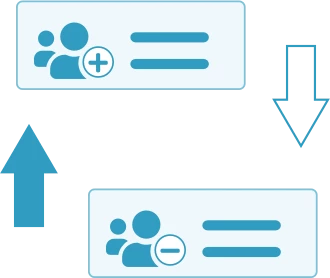Every manager in industries that rely on shift workers knows that scheduling can be a daunting task. From managing sudden absences to ensuring optimum shift coverage, the responsibility can often feel overwhelming. Yet, mastering the art of shift coverage is essential for business success, employee satisfaction, and customer contentment.
Let’s dive into the intricacies of scheduling shift workers and the importance of striking a balance between overstaffing and understaffing. We’ll also look at how modern solutions, such as employee scheduling software, can be your saving grace.
The Challenge of Scheduling Shift Workers

For organizations requiring 24/7 shift coverage, there are typically three primary shifts: morning, evening, and night. Each of these shifts can have its own demands and coverage requirements. The night shift, for instance, might be quieter in some industries but can be more challenging due to the unnatural working hours. Ensuring that no shift is consistently more burdensome than others requires a thoughtful distribution of tasks and responsibilities and number of employees.
Unpredictable Absences and Varied Availability
Employees might call in sick, have emergencies, or request days off, leading to unexpected gaps in the schedule. Additionally, some workers might have specific availability due to other commitments or preferences, making it a jigsaw puzzle for managers to ensure smooth operations.
Balancing Employee Needs and Business Needs
An ideal schedule not only meets the company’s operational needs but also respects employees’ preferences. Finding this balance can be tricky, as ensuring business continuity may sometimes clash with individual needs.
Managing Employee Health and Well-being
Numerous studies have highlighted the health risks associated with irregular or night shift work, including sleep disorders, increased stress, and a higher risk of certain diseases. In fact, shift workers have on average, a 40% increased risk for ischemic heart disease compared to typical workers. Managers need to be considerate of these risks, providing ample breaks, ensuring rotations to avoid prolonged night shift periods, and offering health and wellness support where necessary.
The Perils of Overstaffing and Understaffing
Both overstaffing and understaffing have significant drawbacks, and avoiding these extremes is crucial for any business’s profitability and health. Finding the balance between these two is the ideal for good shift coverage.
Overstaffing: Wasted Resources and Decreased Morale

When too many employees are scheduled for a shift, several problems arise:
- Increased Costs: Overstaffing leads to unnecessary wage expenses and can significantly reduce profit margins. Sometimes, overstaffing leads to unnecessary overtime, which of course requires overtime pay.
- Decreased Productivity: When there are more employees than required, workers might feel there’s less work to do, leading to complacency. This can have a range of negative impact including poor customer service!
- Reduced Morale: Employees might feel undervalued or underutilized, which can affect their job satisfaction and motivation.
Understaffing: Strained Workers and Unsatisfied Customers
The pitfalls of understaffing include:
- Overburdened Employees: Staff members might feel overwhelmed with the amount of work, leading to burnout and decreased job satisfaction.
- Decreased Service Quality: Fewer workers can result in longer waiting times for customers or reduced product/service quality.
- Loss of Business: Unsatisfied customers might choose competitors over you, leading to reduced sales and tarnished reputation.
The Role of Employee Scheduling Software
In the age of digitization, managers can benefit immensely from employee scheduling software. These platforms are designed to simplify the complex task of creating 24/7 schedules, providing several advantages:
Efficiency and Accuracy

Scheduling software can quickly generate schedules based on the input parameters, such as employee availability, preferred hours, and business rules. This not only saves time but also reduces human errors that can occur with manual scheduling.
Flexibility and Adaptability
If an employee calls in sick or requests a day off, employee scheduling software like Celayix can instantly suggest the best replacement based on factors like skills, availability, and work hours. It can also enable you to use rotating shifts (check out our blog on rotating shift schedules here). This adaptability ensures continuous shift coverage without overburdening certain employees.
Employee Empowerment
Many scheduling platforms allow employees to set their availability, swap shifts with peers, or request time off. This involvement can increase employee morale as they feel more freedom and control over their work-life balance.
Data-Driven Decisions
Scheduling systems often comes with analytics capabilities. Managers can access insights into shift patterns, employee preferences, busiest hours, and more. This data can guide future scheduling decisions and optimize staffing levels.
Improved Communication
Immediate notifications about shift changes, reminders, or updates can be sent through these platforms, ensuring everyone is on the same page. This communication minimizes misunderstandings and enhances team cohesion.

Mastering the art of shift coverage is undeniably challenging, but it’s a challenge worth conquering. By understanding the intricacies of employee scheduling, recognizing the dangers of overstaffing and understaffing, and leveraging the power of employee scheduling software, managers can streamline operations, boost employee morale, and ensure customer satisfaction.
In our fast world, businesses that focus on efficient shift coverage will succeed, keep employees happy, and gain loyal customers. If you’d like to see how Celayix can help you master shift coverage, get in touch today to see a free, custom live demo!





